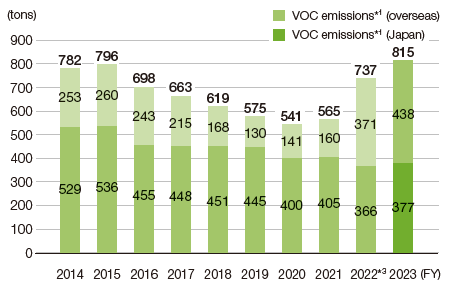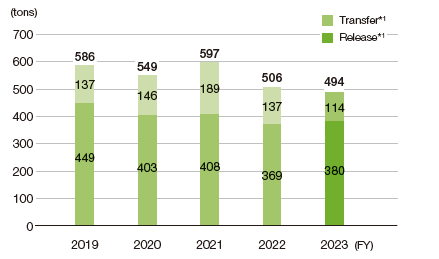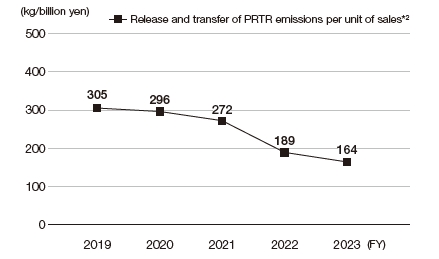Controlling Chemical Substances
Chemical substances have become an essential part of our lifestyles. On the other hand, to control the impact of chemical substances on humans and ecosystems, countries are strengthening laws and regulations related to their use and management.
The Kubota Group sees controlling chemical substances as one of its materiality issues, and has been advancing initiatives toward reducing the burden on the environment from chemical substances, including the reduction of VOCs (volatile organic compounds) generated in coating processes at production sites, as well as the replacement of fluorocarbons and the prevention of leakage.
- Activities towards achieving SDGs
- Medium-Term Environmental Conservation Targets and the Results
- Controlling and reduction of chemical substances in production sites
- Control of Ozone-depleting Substances
- Control of Air Pollutants
- Monitoring Groundwater
- Reduction of Chemical Substances Contained in Products
Activities towards achieving SDGs
| Related SDGs and targets |
 |
|---|---|
| Major Activity Content |
|
| 2025 Activity Targets (KPIs) |
|
Medium-Term Environmental Conservation Targets and the Results
| Action item | Management indicator*2 | Scope | Base FY | Target for FY2025*3 | Result of FY2023*3 | Achievement Status |
|---|---|---|---|---|---|---|
| Reduce VOCs*1 | VOC emissions per unit of production | Global production sites | 2014 | ▲42% | ▲37.9% | We are promoting the elimination or reduction of VOC-contained paint and thinner. |
- *1.VOCs (volatile organic compounds) refer to the substances that are most prevalent in the emissions of the Kubota Group. Up until 2022, there were six substances:xylene, toluene, ethylbenzene, styrene, 1, 2, 4- trimethylbenzene, and 1, 3, 5-trimethylbenzene. Since FY2023 there have been five substances: xylene, toluene, ethylbenzene, styrene, and trimethylbenzene.
- *2.The figures per unit of production represent the intensity of the environmental load per unit of money amount of production. The exchange rate of the base year is used when translating the money amount of production of overseas sites into Japanese yen.
- *3.▲ indicates a negative figure.
Controlling and reduction of chemical substances in production sites
1. VOC Emissions
In FY2023, VOC emissions were 815 tons, an increase of 11% compared to the previous year. Also, VOC emissions per unit of sales were improved by 1.9% year on year.
In Japan, VOC emissions were increased by 11 tons owing to an increase in production volume at some casting and machinery production sites that use a large amount of VOCs. Overseas sites promoted reduction measures such as switching to paints that do not contain VOCs and parts that do not require painting, but as a result of a significant increase in production volume, VOC emissions increased by 67 tons. VOC emissions per unit of sales improved as consolidated net sales increased (up 12.8% from the previous year).
-
Trends in VOC Emissions and Emissions per Unit of Sales
- *1.VOCs refer to the substances that are most prevalent in the emissions of the Kubota Group. Up until FY2022, there were six substances: xylene, toluene, ethylbenzene, styrene, 1, 2, 4-trimethylbenzene, and 1, 3, 5-trimethylbenzene. Since FY2023 there have been five substances: xylene, toluene, ethylbenzene, styrene, and trimethylbenzene.
- *2.VOC emissions per unit of consolidated net sales. The Kubota Group adopted International Financial Reporting Standards (IFRS) instead of accounting principles generally accepted in the United States of America from FY2018.
- *3.Figures for FY2022 have been adjusted in order to improve accuracy.
2. Measures to Reduce VOCs
The Kubota Group has established the Medium-Term Environmental Conservation Targets and is working to reduce the emissions of VOC at production sites. The Group has been promoting the risk management of the chemical substances we handle and the reduction of VOC-containing materials, such as paint and thinner at production sites. Especially in the painting process, not only have we reduced the amount of wasted paint by improving the efficiency of coating, but we are making every effort to stabilize VOC removal efficiency at sites that have deodorization equipment.
In FY2023, we took steps to reduce the amount of paint used, switch to less VOC paints, and recover and recycle thinner.
As a result of the efforts toward achieving the Medium-Term Environmental Conservation Targets 2025 for VOC reduction, global production sites achieved a reduction of 18 tons in FY2023 compared to the case where countermeasures were not implemented from the previous year.
VOC emissions per unit of production in FY2023 were improved by 37.9% compared to the base year (FY2014).
We will continue to promote the reduction of VOC emissions by introducing exhaust treatment equipment that is conscious of compliance with laws and the reduction of impacts on neighborhoods, in addition to the efforts to stop the use of VOC-containing paint and thinner or replace them with substitutes.
-

Kubota Engine (WUXI) Co., Ltd. (China) has installed a regenerative thermal oxidizer (RTO) and is working to reduce its VOC emissions.
-
VOC Emissions by Region
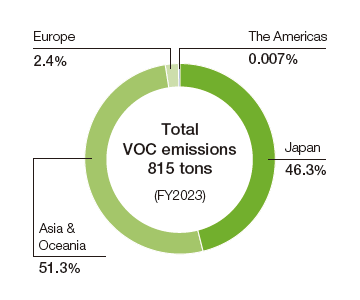
-
VOC Emissions by Business
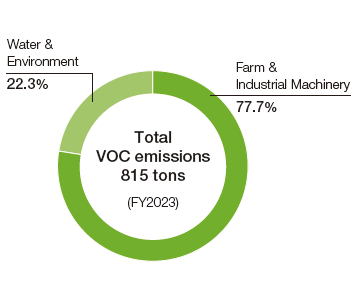
-
VOC Emissions by Substance
-
Japan
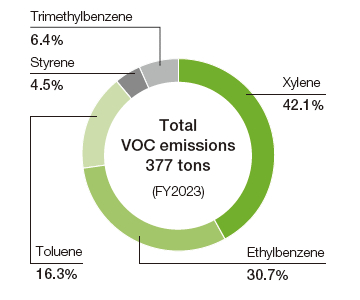
-
Overseas
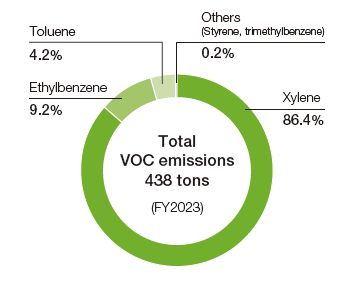
-
Please follow the link below for VOC emission amounts at each production site.
www.kubota.com/sustainability/environment/report/2024/sitereport.html
3. Release and Transfer of PRTR-designated Substances
In FY2023, a total of 494 tons of substances stipulated in the PRTR Law* were released and transferred, a decrease of 2.4% compared to the previous year. Additionally, the release and transfer per unit of sales improved by 13.2% compared to the previous year. Similar to reduction of VOC emissions, the Group is promoting the ongoing measures to reduce PRTR-designated substances.
- Act on Confirmation, etc. of Release Amounts of Specific Chemical Substances in the Environment and Promotion of Improvements to the Management Thereof
-
Trends in Release and Transfer of PRTR-designated Substances, and Release and Transfer per Unit of Sales (Japan)
- *1.Total amount of reported substances that are handled at each site (annual volume of 1 ton or more (or 0.5 tons for Specific Class I designations))
- *2.Release and transfer of PRTR-designated substances per unit of consolidated net sales. The Kubota Group adopted International Financial Reporting Standards (IFRS) instead of accounting principles generally accepted in the United States of America from FY2018.
Control of Ozone-depleting Substances
The Kubota Group prohibits specified CFCs, which are ozone-depleting substances, from being contained in products or added*1 in manufacturing processes of products. In Japan, replacement of materials containing dichloropentafluoropropane with substitute materials was completed during FY2016, and no ozone-depleting substances subject to notification under the PRTR Law*2 are handled and released at present.
In Japan, CFCs that are used in air-conditioners and refrigerating or freezing equipment as refrigerant, are thoroughly managed to control leakage, in accordance with the standards specified by the Fluorocarbons Emission Control Law*3.
- *1.For HCFC, intentional adding in products as refrigerant or heat insulator is prohibited.
- *2.Act on Confirmation, etc. of Release Amounts of Specific Chemical Substances in the Environment and Promotion of Improvements in the Management Thereof
- *3.Act on the Rational Use and Proper Management of Fluorocarbons
Control of Air Pollutants
The Kubota Group has set its own control values that are stricter than the emission standards of relevant laws and regulations. In order not to allow the exceeding of standard values, the Group implements thorough daily management activities, such as monitoring operation of the smoke and soot-generating facilities and inspecting the dust-collecting equipment.
The amounts of emissions of air pollutants in FY2023 were 5.5* tons for SOx (up 4.2% from the previous year), 62.9 tons for NOx (down 3.7%), and 32.1 tons for soot and dust (down 13.8%). We will continue to reduce emissions of air pollutants through initiatives such as controlling sources by fuel conversion and maintaining dust-collecting equipment.
- At a site in Japan, sulfur emissions are calculated, not from actual measurements of exhaust gas concentrations and amounts, but by making estimates based on the sulfur weights of raw materials, materials produced, and waste. (Atmospheric emissions = coal input - iron produced - waste slag - waste dust)
Monitoring Groundwater
Results of groundwater measurements conducted on the premises of the business sites that used organic chlorine-based compounds in the past are as shown below.
| Business site | Substance | Measured groundwater value | Environmental standard |
|---|---|---|---|
| Kubota Tsukuba Plant | Trichloroethylene | Non-detected (less than 0.0001 mg/L) | Less than 0.01 mg/L |
| Kubota Utsunomiya Plant | Trichloroethylene | Non-detected (less than 0.001mg/L) | Less than 0.01 mg/L |
Reduction of Chemical Substances Contained in Products
The Kubota Group has set rules for identifying and properly managing chemical substances in products in order to comply with REACH Regulations* in Europe and other chemical substance regulations.
Since 2010, chemical substances in products have been classified as one of the three following categories and managed appropriately. With cooperation from our suppliers, we investigate chemical substances in products on a global basis.
- The European Union (EU) Regulations for Registration, Evaluation, Authorization and Restriction of Chemicals
- Three Control Levels -
- Substances to be Prohibited: Should not be contained in products
- Substances to be Restricted: Should not be contained in products under certain conditions and applications
- Substances to be Controlled: Presence in products should be recognized
